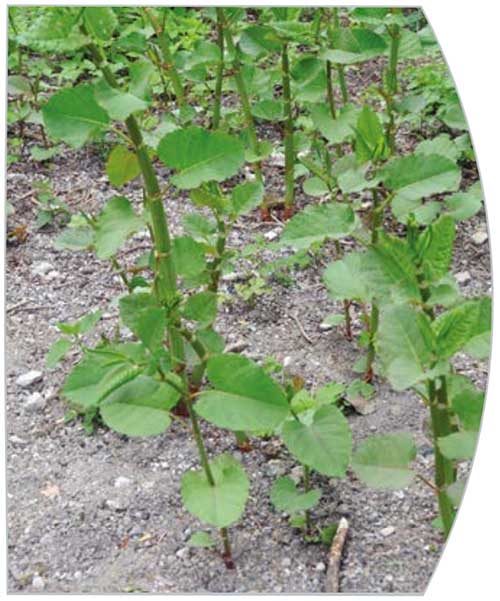 |
CuTex Copper Composite Root Barrier
- Linear Feet: 82 feet per roll
- Orders typically ship same day if placed before 12:00 Noon, EST
- Contact us for volume pricing on orders over $10,000
- Would You Like a Written Quote?
Effective Tree and Plant Root Protection.
CuTex is a permeable geocomposite root barrier system consisting of a specially formulated copper sheet mechanically encapsulated between two high strength geotextiles. CuTex acts by safely releasing Cu2+ ions to inhibit root growth. The copper ions create a localized zone of inhibition which when approached by root tips causes them to undergo a progressive collapse.
The copper acts as a signal layer that all plants avert their growth from. CuTex only releases minute quantities of the copper ion and is a safe, yet effective root growth blocking material.
CuTex can provide direct protection from invasive weeds and plants. Particularly the risk posed by Japanese Knotweed to environments such as utilities’ infrastructures and foundations, across a wide range of industries including construction, highways, rail and water.
The Centre for Plant Sciences at the University of
Leeds independently assessed the effectiveness
of CuTex as a root barrier to Japanese Knotweed,
and other invasive plant species. The research was
designed to answer three principal questions:
What does the word "control" mean in the referenced studies?
In these studies the term "control" is the test when the CuTex barrier is not used. Think of it as "without CuTex".
Does CuTex inhibit root Growth?
Answer: YES
In order to assess whether CuTex can effectively inhibit
root growth the University used a range of approaches
with different plant species. Testing in a sterile culture
using Arabidopsis Thaliana demonstrated how CuTex
creates a ‘zone of inhibition’ whereby roots grow
towards this zone, but then ceased at a distance of
approximately 1.5cm from the composite. Even when
seedlings were established at different distances all
roots stopped at this zone, and seedlings trying to
establish within the zone failed to do so.
The most effective demonstration of CuTex was a setup using an upper layer of vermiculite and a lower compost
layer separated by CuTex. The vermiculite contains no nutrients to support the development of the plant, and
thus the long-term growth and survival of the plant depends on growing through the CuTex. The experiment was
conducted using a number of plant species, including Japanese Knotweed, with the CuTex being assessed against
a control fabric.
Does the effectiveness of CuTex increase with time?
Answer: YES
CuTex in soil will effectively form a chemical barrier as
the Cu2+ ions diffuse into the soil. It was hypothesized
that the effectiveness of the CuTex increases with
time. This was tested by pre-incubating CuTex in an
agar media for a period of 4 weeks following which
time seeds were sown. The plates where the CuTex
had been allowed to incubate indicated a much
stronger and larger zone of inhibition abolishing the
growth of the seeds.
Is CuTex safe?
Answer: YES
The bio-safety of CuTex was tested by assessing how
it affects the overall health and growth of plants.
Whilst CuTex prevents plants from growing through
the composite and within the zone of inhibition, the
effects were shown to be relatively localized. CuTex
was not shown to negatively affect the biomass of
surrounding plants.
Japanese Knotweed
Japanese Knotweed is a strong growing herbaceous plant native to
Japan, Taiwan, China, and the Korean
peninsula. It was introduced into
Europe in the mid-19th Century as an
ornamental plant. The plant has
thrived in fertile European soils and is
now classified as an aggressive weed
species. The plant has a significant
negative impact on the environment
where it occurs. Japanese Knotweeds
stout rhizomes can push through
asphalt, building foundations, cracks
in concrete, retaining walls and even
drains.
It out-competes other species affecting landscaping
programs, it disturbs the aesthetics through
the accumulation of litter in dense thickets which
encourages vermin and it increases the maintenance
costs of buildings. It can also disturb local ecosystems
by blocking migration of native plants and animals.
This can add huge costs to development and
regeneration schemes.
Contaminated soil must be treated as controlled
waste. Additionally, the plant is capable of obscuring
railway signals and road signs as well as causing
trip hazards in paving. Hence, Japanese Knotweed
can cause excessive costs for remediation, lead to
prosecution and/or compensation claims, especially
from neighboring sites, physical damage to buildings,
hard surfaces and harm to the environment (through
the repeated applications of herbicides).

How Does CuTex Work?
CuTex functions not only as a physical
barrier, incorporating strong and
durable geotextiles, but also as a
chemical barrier. It acts by releasing
Cu2+ ions into solution. Confocal laserscanning microscopy and differential
contrast interference microscopy was
used to analyze the morphology of root
tips grown in the presence and absence
of CuTex. The results demonstrated
that when root tips approach the zone
of inhibition they undergo a progressive
collapse. The dividing cells at the very
tip of the root (the meristem) die off
and the cells above the meristem
differentiate.
The localized copper toxicology only affects the root
exposed to the zone of inhibition making CuTex a safe
and effective material for blocking root growth. Over
time CuTex releases Cu2+ ions into the soil creating an
effective chemical barrier.
CuTex Shipping Time
CuTex barrier orders typically ship same day (M-F) if order is placed before 12:00 noon EST. Transit times displayed in the map are listed in business days and are approximate.
The transit times displayed on the map is for standard ground shipping.
|
|
 |